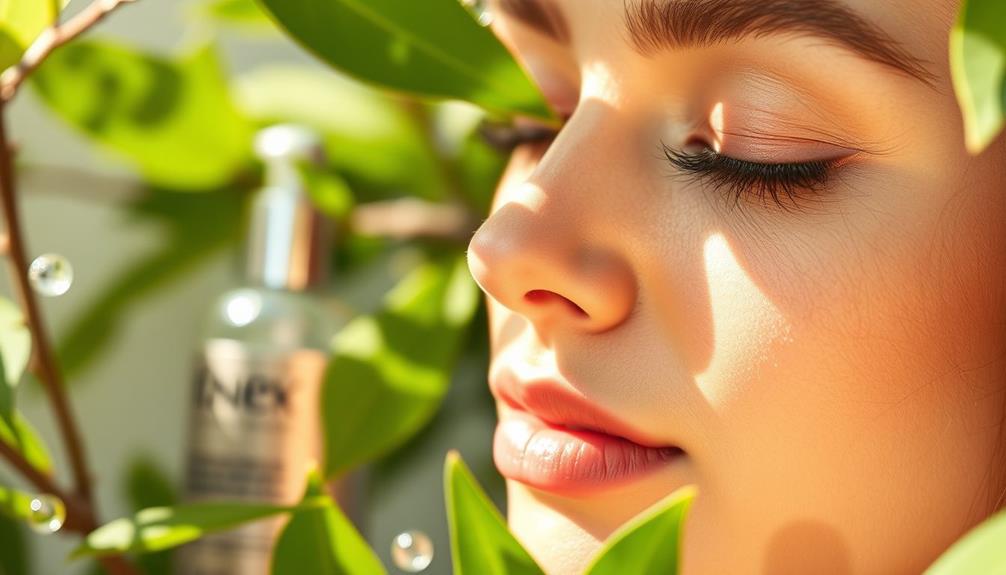Glycolic acid works wonders for keratosis pilaris by exfoliating your skin and breaking down the buildup of keratin around hair follicles. This alpha-hydroxy acid promotes cell turnover, helping you shed dead skin cells for a smoother texture over time. Regular use can lead to a noticeable reduction in those pesky bumps, especially at higher concentrations. Plus, glycolic acid enhances moisture retention, alleviating dryness. You'll want to apply moisturizer afterward to maintain hydration. If you're curious about how to maximize results and handle potential side effects, there's plenty more to explore on this topic.
Key Takeaways
- Glycolic acid exfoliates the skin, reducing keratin buildup and promoting cell turnover, which helps smoothen the rough bumps of keratosis pilaris.
- Regular use of glycolic acid (50-70% concentration) can significantly decrease keratotic papules and improve skin hydration.
- The small molecular size of glycolic acid allows for deeper penetration and effective exfoliation, leading to smoother skin over time.
- Post-treatment moisturization is crucial for maintaining hydration and enhancing the overall effectiveness of glycolic acid treatments.
Understanding Keratosis Pilaris

Keratosis pilaris (KP) is a common skin condition that causes tiny, rough bumps on your arms and thighs due to keratin buildup around hair follicles. This buildup occurs when dead skin cells accumulate, forming keratin plugs that trap hair and create those characteristic bumps.
Essential oils such as cedarwood oil may help balance oil production in the scalp, which is relevant as healthy scalp care can contribute to overall skin health. If you have sensitive skin, you might notice that KP worsens during dry seasons or in conjunction with conditions like eczema.
While keratosis pilaris isn't harmful, it can be frustrating. It affects around 40% of adults and 50-80% of adolescents. You may find that your skin feels dry and itchy as a result.
Fortunately, managing KP is possible with a proper skin care routine. Regular exfoliation is key, as it helps remove dead skin cells and prevent keratin plugs from forming. Incorporating gentle exfoliating products into your regimen can make a noticeable difference.
Although KP tends to improve with age, consistent care is essential for maintaining smoother skin. By focusing on effective skin care practices, you can minimize the appearance of keratosis pilaris and enhance your skin's texture.
Role of Glycolic Acid

Glycolic acid plays an essential role in treating keratosis pilaris by effectively exfoliating the skin and reducing keratin buildup.
As an alpha-hydroxy acid, it helps remove dead skin cells that can clog hair follicles and contribute to the formation of rough, bumpy skin associated with KP.
By promoting cell turnover, glycolic acid encourages the shedding of old skin cells and the growth of new ones, which can greatly improve your skin texture.
When used regularly, glycolic acid can lead to noticeable improvements in the appearance of keratotic papules.
Research shows that higher concentrations, between 50-70%, can achieve up to a 60% reduction in visible bumps over time.
This not only smooths the skin but also enhances the effectiveness of other products, allowing for better hydration and treatment outcomes.
Incorporating glycolic acid into your skincare routine can provide long-term benefits, though individual results may vary. Many individuals report seeing improvements in their skin texture, tone, and overall appearance after incorporating glycolic acid into their routine. However, it is important to note that results can vary depending on factors such as skin type, frequency of use, and other skincare products used in conjunction. According to experts’ insights on glycolic acid, it is best to start with a lower concentration and gradually increase as your skin builds tolerance. Additionally, it is recommended to use sunscreen daily when using glycolic acid products to protect your skin from increased sensitivity to the sun.
By addressing the underlying issues of keratin buildup and promoting healthier cell turnover, you can achieve a smoother, more even skin texture and alleviate the symptoms of keratosis pilaris effectively.
Aromatherapy offers holistic approaches that can complement skincare treatments by promoting relaxation and overall skin health.
Mechanism of Action

Often, glycolic acid effectively breaks down the bonds between dead skin cells, promoting their removal and enhancing cell turnover. This alpha-hydroxy acid penetrates your skin easily due to its small molecular size, allowing for deeper exfoliation.
When dealing with keratosis pilaris, glycolic acid specifically targets the keratin plugs that contribute to the bumpy texture of your skin. By dissolving these plugs, it helps to reveal smoother skin over time.
Regular use of air purifiers can also support skin health by improving indoor air quality and reducing allergens that may exacerbate skin conditions.
In addition to exfoliation, glycolic acid enhances your skin's moisture retention, which can alleviate the dryness often associated with keratosis pilaris. This improved hydration can further contribute to a more even skin surface.
Studies show that using higher concentrations of glycolic acid, particularly in the range of 50% to 70%, can lead to significant reductions in keratotic papules and an overall improvement in skin appearance.
Treatment Protocols

For effective treatment of keratosis pilaris, applying glycolic acid in targeted protocols can greatly improve skin texture and reduce keratotic papules. Typically, you'll use glycolic acid, an alpha-hydroxy acid, in concentrations between 50% and 70%.
Following a holistic lifestyle approach, including adequate sleep and stress management, can further enhance your skin's response to treatment.
Follow a structured schedule, applying the acid on designated days—like days 0, 20, 40, and 60—to track your skin's response to the treatment.
You should expect improvements in skin roughness and a noticeable decrease in keratotic papules over time, with studies indicating up to a 60% reduction by day 80.
After each glycolic acid application, it's essential to apply a moisturizer to maintain skin hydration and prevent irritation, as dryness can be a common side effect.
As you continue your treatment protocols, consider adjusting the concentration and frequency of glycolic acid based on how your skin reacts. This personalized approach maximizes efficacy while minimizing potential adverse effects.
Expected Results

You can expect noticeable improvements in skin texture and a significant reduction in keratosis pilaris bumps with consistent use of glycolic acid. This powerful alpha-hydroxy acid works by exfoliating the skin, removing dead cells, and helping to smooth out those pesky bumps. Many users report rapid improvements in their skin's appearance, particularly after incorporating glycolic acid into their treatment routine.
Here are some expected benefits you might notice:
- Smoother Skin: Glycolic acid can lead to a visibly smoother skin texture.
- Reduction in Bumps: You may see a significant improvement in keratosis pilaris bumps.
- Fading Hyperpigmentation: Regular use can help decrease discoloration associated with keratosis pilaris.
- Enhanced Hydration: Combining glycolic acid with moisturizers can keep your skin hydrated and maintain its barrier function.
Safety and Side Effects

When using glycolic acid for keratosis pilaris, it's important to be aware of potential side effects, like mild irritation or dryness, especially at first.
Long-term use is generally safe, but you should monitor your skin's reactions closely.
Always consult your dermatologist if you notice severe irritation or other unexpected issues.
Common Side Effects
Glycolic acid can cause common side effects like redness, dryness, and peeling, particularly at higher concentrations. While most users experience mild reactions, some individuals with sensitive skin may face increased skin irritation. To minimize adverse effects, it's essential to perform a patch test before applying glycolic acid products widely.
Here are some potential side effects you might encounter:
- Redness and inflammation
- Dry skin or flaking
- Peeling or exfoliation of the skin
- Increased sensitivity to sunlight
If you notice any severe reactions, like persistent redness or a burning sensation, it's advisable to reduce the frequency of use or discontinue the product altogether. Consulting with a dermatologist can help guarantee you're using glycolic acid safely, especially if you have sensitive skin.
Remember that while glycolic acid is effective for treating keratosis pilaris, taking precautions will help you avoid discomfort and achieve the best results. Always follow product instructions carefully to minimize risks and protect your skin's health.
Long-term Safety Considerations
Long-term use of glycolic acid for treating keratosis pilaris generally shows a favorable safety profile, with minimal side effects reported in clinical studies.
Most participants tolerate the treatment well, and studies have demonstrated a 100% completion rate, reinforcing its viability as an option for managing this condition.
When applied as directed, no significant adverse effects were noted, even with high concentrations of glycolic acid, which supports its long-term use.
While individual responses to treatment can vary, participants reported varying levels of improvement without experiencing major complications. This variability suggests that while glycolic acid is effective, continuous assessment of treatment strategies may be necessary to maintain results over time.
It's important to stay attentive to how your skin responds during long-term treatment. Monitoring for any potential reactions guarantees you can adjust your approach as needed.
Monitoring Treatment Reactions
Monitoring your skin's reaction to glycolic acid is vital, as even well-tolerated treatments can sometimes lead to mild irritation or dryness. While most users report positive outcomes, keeping an eye on how your skin responds helps verify you're using the product effectively and safely.
Here are some key points to reflect on while monitoring treatment reactions:
- Check for irritation: Look for redness, itching, or peeling as signs of mild irritation.
- Adjust application frequency: If you experience discomfort, think about reducing how often you apply glycolic acid.
- Assess skin condition: Regularly evaluate your skin for any changes in texture or clarity.
- Use on damp skin: This technique enhances absorption and can minimize side effects.
Long-term Care Strategies

Consistent application of exfoliating treatments, especially those with glycolic acid, is essential for maintaining smooth skin and preventing keratin buildup in keratosis pilaris. This long-term care strategy involves using glycolic acid lotions or creams regularly, ideally on damp skin right after bathing. This method enhances absorption and maximizes the effectiveness of the treatment of keratosis pilaris.
In addition to exfoliation, regular moisturizing is critical. Look for products that contain urea or lactic acid, as they help soften your skin and improve texture, reducing the appearance of rough bumps. Establishing a weekly exfoliation schedule with glycolic acid treatments can greatly manage flare-ups, particularly during winter months when your skin is drier.
However, it's important to monitor your skin sensitivity. Adjust the frequency of glycolic acid application based on how your skin reacts to avoid irritation while still reaping the long-term benefits for keratosis pilaris.
Frequently Asked Questions
How Long Does It Take for Glycolic Acid to Work on Chicken Skin?
When using glycolic acid for chicken skin, you might start noticing improvements within 2 to 4 weeks of consistent application. However, results can vary, so patience and regular use are key for the best outcomes.
Should You Shower Every Day if You Have Kp?
If you have keratosis pilaris, showering daily can help remove dead skin cells, but avoid hot water to prevent dryness. Aim for lukewarm showers, limit time, and always moisturize afterward for ideal results.
How Long Does It Take to Remove Keratosis Pilaris?
Imagine you start a new skincare routine. You'll likely see some improvement in your keratosis pilaris within 4 to 8 weeks, but expect ongoing care to maintain those results and prevent any return.
Is It Good to Exfoliate Keratosis Pilaris?
Yes, it's good to exfoliate keratosis pilaris. Regular exfoliation helps remove dead skin cells, reducing the rough bumps. Just be careful not to overdo it; monitor your skin's response to avoid irritation.
Conclusion
In your journey to smoother skin, glycolic acid can be your trusty ally against keratosis pilaris.
Like a gentle tide washing over rough shores, it exfoliates and reveals a fresher layer beneath.
By embracing this treatment, you're not just tackling a skin condition; you're reclaiming your confidence and comfort.
Remember, just as seasons change, so can your skin with consistent care and patience.
Keep nurturing yourself, and you'll uncover the beauty that's been waiting beneath the surface.









